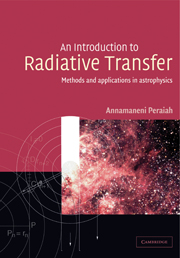Book contents
- Frontmatter
- Contents
- Preface
- Chapter 1 Definitions of fundamental quantities of the radiation field
- Chapter 2 The equation of radiative transfer
- Chapter 3 Methods of solution of the transfer equation
- Chapter 4 Two-point boundary problems
- Chapter 5 Principle of invariance
- Chapter 6 Discrete space theory
- Chapter 7 Transfer equation in moving media: the observer frame
- Chapter 8 Radiative transfer equation in the comoving frame
- Chapter 9 Escape probability methods
- Chapter 10 Operator perturbation methods
- Chapter 11 Polarization
- Chapter 12 Polarization in magnetic media
- Chapter 13 Multi-dimensional radiative transfer
- Symbol index
- Index
Chapter 8 - Radiative transfer equation in the comoving frame
Published online by Cambridge University Press: 05 June 2012
- Frontmatter
- Contents
- Preface
- Chapter 1 Definitions of fundamental quantities of the radiation field
- Chapter 2 The equation of radiative transfer
- Chapter 3 Methods of solution of the transfer equation
- Chapter 4 Two-point boundary problems
- Chapter 5 Principle of invariance
- Chapter 6 Discrete space theory
- Chapter 7 Transfer equation in moving media: the observer frame
- Chapter 8 Radiative transfer equation in the comoving frame
- Chapter 9 Escape probability methods
- Chapter 10 Operator perturbation methods
- Chapter 11 Polarization
- Chapter 12 Polarization in magnetic media
- Chapter 13 Multi-dimensional radiative transfer
- Symbol index
- Index
Summary
Introduction
In chapter 7, we studied the solution of the transfer equation in the rest frame of the observer. There are two difficulties in this way of treating the transfer equation: (1) the absorption and emission coefficients become angle dependent due to Doppler shifts in the frequency of the photon and hence become anisotropic and aberration of light is generated; and (2) the coupling between angle and frequency creates the practical problem of dealing with an unmanageably large mesh size for computation in scattering problems. This restricts the expansion velocities to a few times the mean thermal velocities. When the expansion velocities are very high one needs to use the comoving frame or the moving frame of the material. As the observer is with the moving frame, no Doppler shifts in the frequency of the photon occur and the opacity and emissivity are isotropic. One can use the redistribution functions for a static atmosphere. For problems involving scattering integrals, one can use a line profile with a band width which contains the full profile and which does not contain the velocity components. This makes the angle–frequency mesh small enough to contain the full profile of a static medium.
Lorentz transformations are used to describe the change (in the relevant physical variables) between the rest and comoving frames. Lorentz transforms are applicable when the relative velocity of the two frames is uniform and constant. In reality we find that the velocities are functions of not only radii but also time.
Information
- Type
- Chapter
- Information
- An Introduction to Radiative TransferMethods and Applications in Astrophysics, pp. 217 - 263Publisher: Cambridge University PressPrint publication year: 2001
